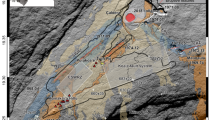Abstract
Field analysis and differential interferometry derived from Synthetic Aperture Radar (PALSAR) of the epicentral area of the May 12 2008 M w 8.0 Wenchuan (汶川) earthquake zone reveal details about fault ruptures and ground displacements, with field-documented vertical offsets reaching 12 m along the trace of the main fault rupture, and PALSAR-measured horizontal displacements reaching 12.3 m. We document slip indicators on the fault scarp that show initially sub-horizontal then progressively steeper slip increments with time along the same fault during the 2 min earthquake, suggesting that the rupture propagated as a mixed Mode II–III fracture, with strike-slip movement at the tip directing energy from the initial rupture to points north of the epicenter, followed by vertical displacement in the interior of the slipped region. Field, seismic, and PALSAR-measured displacements are dominantly thrust near the epicentral region, and dextral in northeasterly areas, showing that slip was partitioned along the fault in space and time during the earthquake. The changing slip directions may correlate with three main pulses of energy release at 0, 23, and 57 s during the earthquake as recorded by seismograms. The earthquake generated massive landslides >100 km north of the epicenter along the trace of the fault. These massive sturzstroms formed where entire mountainsides collapsed and moved at high velocity down populated mountain valleys, jumping smaller mountains and ricocheting off steep canyon walls. These avalanches rode on cushions of water and compressed air that generated air blasts from beneath the debris, knocking down trees high on opposing mountain slopes. The concentration of massive landslides and ground deformation so far north of the epicenter was related to the Mode II-III fracture propagation focusing seismic energy along the fault towards the north, explaining why so much devastation occurred >100 km from the epicenter, such as in the destroyed city of Beichuan (北川). Understanding near-surface earthquake processes and geological hazards associated with massive earthquakes in populated mountainous areas has the potential to save many lives in the future.
Similar content being viewed by others
References Cited
Burchfiel, B. C., Chen., Z. L., Liu, Y. P., et al., 1995. Tectonics of the Longmen Shan and Adjacent Regions. Int. Geol. Rev., 37(8): 661–735
Burchfiel, B. C., Royden, L. H., van der Hilst, R. D., et al., 2008. A Geological and Geophysical Context for the Wenchuan Earthquake of 12 May 2008, Sichuan, People’s Republic of China. GSA Today, 18(7): 4–11
Bureau of Geology and Mineral Resources of Sichuan Province, 1989. Atlas of Sichuan Geology, China. Geological Publishing House, Beijing (in Chinese)
Eberhart-Phillips, D., Haeussler, P. J., Freymueller, J. T., et al., 2003. The 2002 Denali Fault Earthquake, Alaska: A Large-Magnitude, Slip-Partitioned Event. Science, 300(5622): 1113–1118
Goldstein, R. M., Werner, C. L., 1998. Radar Interferogram Filtering for Geophysical Applications. Geophys. Res. Lett., 25(21): 4035–4038
Hao, K. X., Si, H. J., Fujiwara, H., et al., 2009. Coseismic Surface-Ruptures and Crustal Deformations of the 2008 Wenchuan Earthquake M w 7.9, China. Geophys. Res. Lett., 36(L11303), doi: 10.1029/2009GL037971
Heim, A., 1932. Bergsturz und Menschenleben. Fretz and Wasmuth Verlag, Zurich. 218 (in German)
Huang, R. Q., Xu, Q., 2008. The Representative Catastrophic Landslides in China. Science Press, Beijing. 553 (in Chinese)
Iverson, R. M., 2003. How should Mathematical Models of Geomorphic Processes be Judged? Geophysical Monograph, 135: 83–94
Kirby, E., Whipple, K. X., Burchfiel, B. C., et al., 2000. Neotectonics of the Min Shan, China: Implications for Mechanisms Driving Quaternary Deformation along the Eastern Margin of the Tibetan Plateau. Geol. Soc. Am. Bull., 112: 375–393
Kusky, T. M., 2008a. Earthquakes: Plate Tectonics and Earthquake Hazards, Hazardous Earth Series. Facts on File, 169
Kusky, T. M., 2008b. Landslides: Mass Wasting, Soil, and Mineral Hazards. Hazardous Earth Series, Facts on File, 128
Legros, F., 2002. The Mobility of Long-Runout Landslides. Engineering Geology, 63(3–4): 301–331
Liu, J. G., Kusky, T. M., 2008. After the 8.0 M w Wenchuan Earthquake: A Report on an International Field Excursion to Investigate the Earthquake Induced Geohazards (6–10 July 2008). Earth Mag., 48: 48–51
Liu, J. G., Tang, C., Kusky, T. M., 2008. Emergency Geohazard Mapping for Wenchuan Earthquake Disaster in China Using ALOS Imagery Data. Proceedings of the 2008 Joint PI Symposium of the ALOS Data Nodes. Rhodes, Greece, Nov. 3
Parsons, T., Ji, C., Kirby, E., 2008. Stress Changes from the 2008 Wenchuan Earthquake and Increased Hazard in the Sichuan Basin. Nature, 454(7203): 509–510
Royden, L. H., Burchfiel, B. C., van der Hilst, R. D., 2008. The Geological Evolution of the Tibetan Plateau. Science, 321(5892): 1054–1058
Tang, H. M., Jia, H. B., Hu, X. L., et al., 2010. Characteristics of Landslides Induced by the Great Wenchuan Earthquake. Journal of Earth Science, 21(1): 104–113
U.S. Geoloigc Survey (USGS), 2008. http://earthquake.usgs.gov/eqcenter/eqinthenews/2008/us2008ryan/
Xu, C., Liu, Y., Wen, Y., et al., 2009. Coseismic and Postseismic Deformation of the 2008 M w 7.9 Wenchuan Earthquake Using GPS and InSAR. Geophys. Res. Abst., 11: EGU2009-3636-1
Xu, Y., 2007. Structural and Stratigraphic Evolution of the Longmenshan Fold-Thrust Belt and Sichuan Basin: Complex Interplay between Extensional and Contractional Tectonics and Basin Formation: [Dissertation]. St. Louis University, St. Louis
Xu, Y., Koper, K. D., Sufri, O., et al., 2009. Rupture Imaging of the M w 7.9 12 May 2008 Wenchuan Earthquake from Back Projection of Teleseismic P Waves. Geochem. Geophys. Geosys., 10, doi: 1029/2008GC002335
Zhou, R. J., Li, Y., Densmore, A. L., et al., 2007. Active Tectonics of the Longmenshan Region and the Eastern Margin of the Tibetan Plateau. Acta Geologica Sinica, 81(4):593–604
Author information
Authors and Affiliations
Corresponding author
Additional information
This study was supported by NASA to Abduwasit Ghulam and Timothy M Kusky (No. 08-182), the National Natural Science Foundation of China (No. 40821061), and Ministry of Education of China (No. B07039).
Rights and permissions
About this article
Cite this article
Kusky, T.M., Ghulam, A., Wang, L. et al. Focusing seismic energy along faults through time-variable rupture modes: Wenchuan earthquake, China. J. Earth Sci. 21, 910–922 (2010). https://doi.org/10.1007/s12583-010-0144-7
Received:
Accepted:
Published:
Issue Date:
DOI: https://doi.org/10.1007/s12583-010-0144-7




